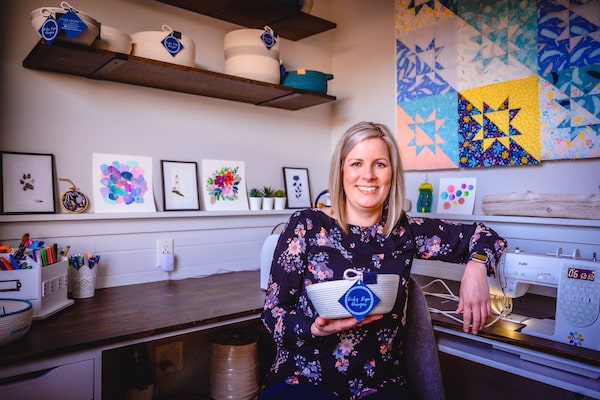
Gillian Chatman is the founder and sole creative talent behind Ruby Rope Designs.RITCHE PEREZ/The Globe and Mail
When Gillian Chatman needs to unwind from her day job with the Newfoundland and Labrador government, she turns to her side gig as founder and sole creative talent behind Ruby Rope Designs.
This side business, named after her dog Ruby, started four years ago with a tutorial on how to make rope bowls. Today her products are sold in a handful of stores in Newfoundland, Ontario and online.
”I mostly do it as a creative outlet,” says Ms. Chatman, whose day job is helping businesses find international markets for their products. “I find it to be a very relaxing activity, one where I can almost zone out once I’m in the groove. [And] there are only so many bowls I can use for myself.”
Ms. Chatman enjoys her side hustle but has no plans to leave her day job – and she’s not alone.

Ms. Chatman enjoys her side hustle but has no plans to leave her day job – and she’s not alone.RITCHE PEREZ/The Globe and Mail
A 2018 report from Statistics Canada found about 5.7 per cent of Canadian workers had multiple jobs – about one million people – and 65.7 per cent of them worked full-time in their main job. The pandemic has also inspired many Canadians to use spare time at home to pursue a side gig. A recent poll showed about a third of Canadians looked for ways to earn extra income during the COVID-19 lockdowns.
For many like Ms. Chatman, after-hours work remains a means for part-time entrepreneurs to make their creative passions pay off.
”My side hustle helps me unwind and because I become focused on that, I don’t often think about my day job during evenings and weekends, a claim I could not previously make,” she says.
In her case, running a small business also complements her day job, where her department works with small businesses daily to provide financial support and business advice.
”Running Ruby Rope Designs has helped me to gain perspective from the other side of the table. In a way, my career and my side hustle are two sides of the same coin,” she says.
Moonlighting is often viewed negatively by employers and managers, but a study published last year in the Academy of Management journal challenged the assumption that a side gig detracts from a day job.
”Generally, there’s been kind of a zero-sum perspective about the arrangement, where every ounce of time and energy you give to your side hustle is an ounce of time and energy taken away from your full-time job,” says Hudson Sessions, an assistant professor in the Cox School of Business at Southern Methodist University in Dallas, and one of the authors of the study.
He and his colleagues surveyed hundreds of side-hustlers and their solo-job co-workers and found that the after-hours hustle can lead to a feeling of empowerment, especially when the work is not solely motivated by making money. When that is the case, co-workers rated side-hustlers’ job performance higher the day after some side-gig work.
”It suggests that sometimes when you have more than one role, it can actually make you better or add to what you bring to the table across all of your roles,” Mr. Sessions says.
It depends on a feeling of empowerment from the work; whether it is meaningful, has impact, and gives the side-hustler a feeling of control and competence.”

For many like Ms. Chatman, after-hours work remains a means for part-time entrepreneurs to make their creative passions pay off.RITCHE PEREZ/The Globe and Mail
People feel empowered when they can take control and have their own venture on the side; that perhaps leads to some positive emotions that then spill over to their full-time jobs. So instead of their side-hustle draining them or taking away from their full-time job, it can actually make them a little bit happier on a daily basis because they do get to be the boss outside of their full-time arrangement,” he says.
Having a side hustle is often frowned upon by employers, but maybe it shouldn’t be, Mr. Sessions adds.
“Instead of just being distracted by having a side hustle, they can actually get a little bit of an uplift by being their own boss and they can bring something extra to their full-time job the next day,” he says. “On a daily level, we’ve found that people are happier when they’ve had these side-hustle empowerment experiences.”
At Durham College in Oshawa, Ont., entrepreneurship and small business course enrolment has grown during the pandemic and many students start their ventures as side gigs to full-time work, says Keri-Ellen Walcer, program co-ordinator for the small business and entrepreneurship program at the School of Business and IT Management.
For some people, a side hustle is a means of earning extra, she says. For others, it’s a low-risk way to explore their passions.
”When you’re able to share that passion with others, and it’s not even really about the money but about being able to see that something you’ve created, something you’re passionate about sharing with other people. It’s very validating when they’re willing to pay you for doing something you enjoy.”
Feeding that creativity improves our quality of life, Ms. Walcer says.
We’ve all heard the adage that if you do something you love, you’ll never work a day in your life. But relying on that something you love to pay the bills can quickly take the joy out of it, she adds.
”People were going to do this thing that they love and turn it into their business and ended up buckling under the pressure. It can become a situation where you used to love it and now you hate it,” she says.
“Having a side hustle is a way to take something that you love, that passion-into-profits idea, and continue to love it because if you don’t feel that same kind of pressure to provide.”

Moonlighting is often viewed negatively by employers and managers, but a study published last year in the Academy of Management journal challenged the assumption that a side gig detracts from a day job.RITCHE PEREZ/The Globe and Mail